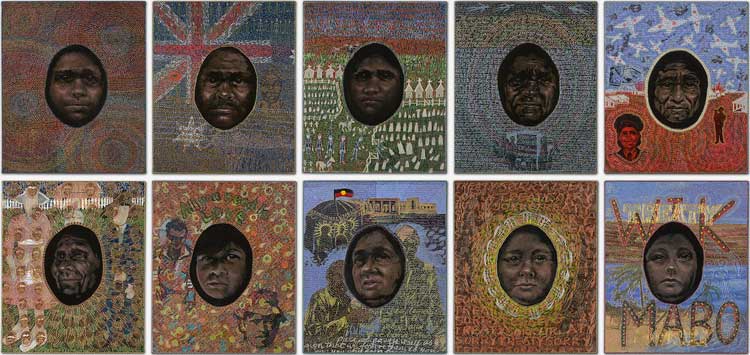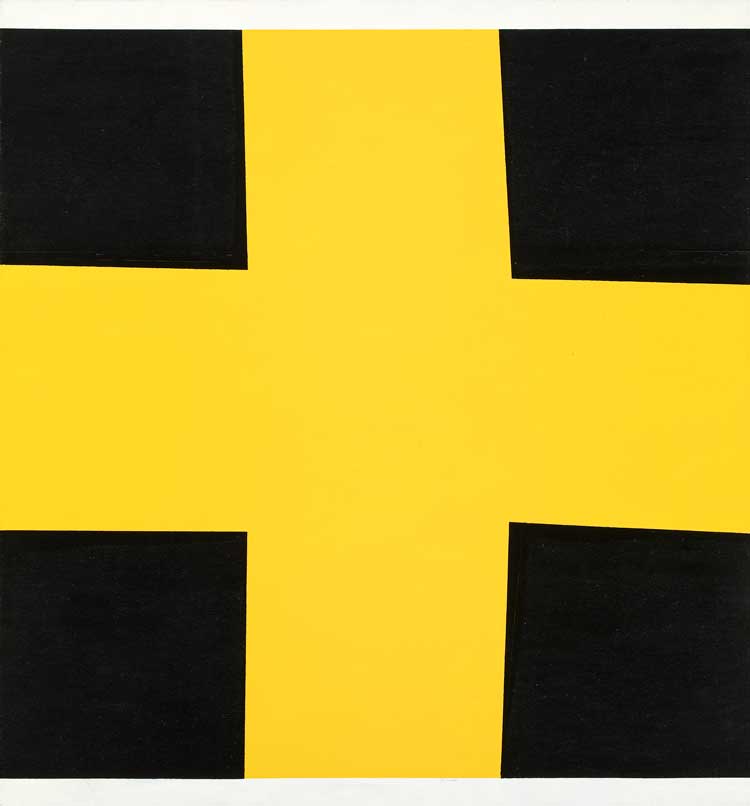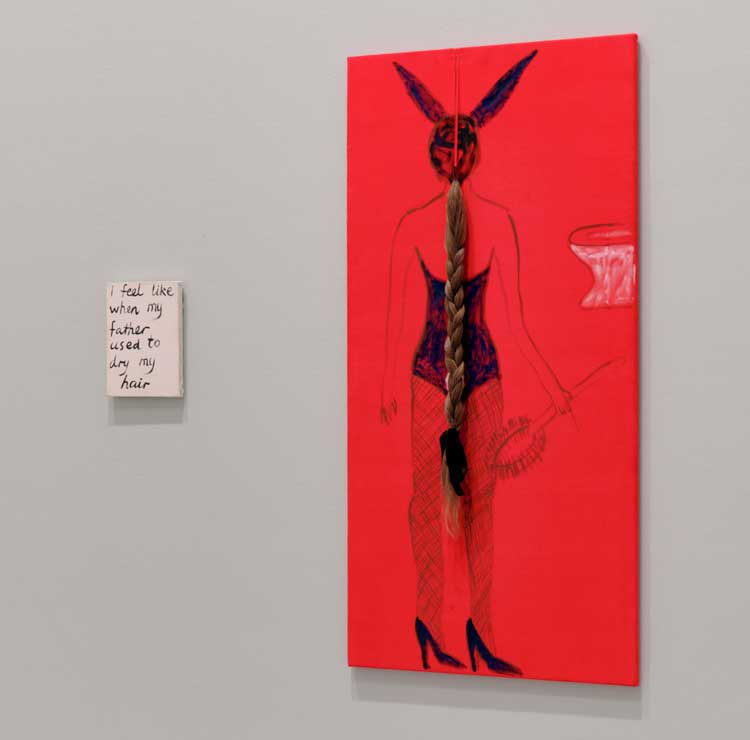.jpg)
Installation view of Naomi Hobson’s Dallas Harold 2018 and Peter Liddy 2018 on display in Who Are You: Australian Portraiture at The Ian Potter Centre: NGV Australia from 25 March to 21 August 2022. Photo: Tom Ross.
The Ian Potter Centre: National Gallery of Victoria, Melbourne
25 March – 21 August 2022
by JANET McKENZIE
Who Are You: Australian Portraiture is a collaboration between the National Gallery of Victoria and the National Portrait Gallery in Canberra. With about 200 works, this is the largest exhibition of portraiture to be presented by either of the galleries, and the most comprehensive. Portraiture enables a rich seam of artworks to represent the history of Australia, where evolving identities over 250 years can be examined and re-evaluated. There are numerous traditional realist and naturalistic works from the 19th and early 20th century, those that challenge portraiture as a true likeness, such as William Dobell’s Helena Rubinstein (1957) through to the abstract work of John Nixon. The sitters range from Queen Elizabeth II by Polly Borland to Boris Cipusev’s typographic portrait of Jeff, from the band the Wiggles. This is a rich and inspiring show with a wide range of Australia’s best artists – past and living – include Lina Bryans, Danila Vassilieff, John Olsen, Patricia Piccinini and Howard Arkley, and the Indigenous artists Ginger Riley Munduwalawala, Christian Thompson, Maree Clarke, Trevor ‘Turbo’ Brown, Vincent Namatjira, Tracey Moffatt and Julie Dowling.

Julie Dowling. Federation series: 1901–2001, 2001. Synthetic polymer paint, earth pigments, metallic paint and glitter on canvas, (1-10) 60.6 × 555 cm (variable) (overall). National Gallery of Victoria, Melbourne Purchased through the NGV Foundation with the assistance of Rupert Myer, Governor, 2001. © Julie Dowling/Licensed by Copyright Agency, Australia.
The subject of portraiture itself is discussed in the excellent accompanying catalogue. Portraiture following the advent of photography has long intrigued art historians; later, in relation to the avant garde, naturalistic portraiture was deemed practically obsolete. In the late 1940s, following the second world war and the loss of faith in humanity, the human image in art became increasingly difficult to portray. The existential despair expressed by Jean-Paul Sartre in Nausea (1938) found a visual counterpart in the images of despair and alienation of Francis Bacon, the expressionism of Oskar Kokoschka, the remarkable post-Vietnam human images of the American-born RB Kitaj, the apocalyptic visions of Arthur Boyd and the anguished figures of the Scottish artist John Bellany. Yet ironically providing a medium of escape, abstraction in the visual arts dominated because, after the horrors of Auschwitz, Hiroshima and Nagasaki, artists mostly found images of humanity impossible to create. John Nixon’s abstract painting (1990) in this exhibition is a self-portrait, represented by a large yellow cross using enamel paint.

John Nixon. Self Portrait (non-objective composition) (yellow cross), 1990. Enamel paint on plywood, 177.6 × 165 cm. National Gallery of Victoria, Melbourne Purchased through The Art Foundation of Victoria with the assistance of Chase Manhattan Overseas Corporation, Fellow, 1991. © Courtesy of the artist.
Conceptual art has informed many of the works in Who Are You. The unique state prints by Mike Parr (b1945) 12 Untitled Self Portraits (1990) are dry point images created from his, at times, vicious attacks on to metal plates. All Parr’s drawing since the 1990s relates to his previous work as a performance artist, which enabled him to establish an intensely personal, intellectual analysis of the world beyond the strict confines of the stage or performance space, the individual or artist in relation to the wider, political world.
.jpg)
Mike Parr. 12 Untitled Self Portraits (Set 3), 1990. Installation view, Who Are You: Australian Portraiture at The Ian Potter Centre: NGV Australia from 25 March to 21 August 2022. Photo: Tom Ross.
His drawings and printmaking, he is keen to point out, are really just drawings on more resistant surfaces, or techniques “that enable me to process and displace marks for the sake of other somatic sensations … deeply inflected by performance”.1 In line with the exploration of his own psyche in performances, Parr chooses the area of self-portraiture as the most intense form of scrutiny in the visual arts in combination with text.

Jenny Watson. A woman’s work is never done + I feel like when my father used to dry my hair, 1992. Installation view, Who Are You: Australian Portraiture at The Ian Potter Centre: NGV Australia from 25 March to 21 August 2022. Photo: Tom Ross.
Jenny Watson’s self-portrait, A Woman’s Work Is Never Done + I Feel Like When My Father Used to Dry My Hair (1992), is made from material with personal associations – fabrics that allude to memory and veiled experiences from her past, resonating strongly with a feminist agenda. Her work makes reference to various art movements of the 1970s, which questioned the validity of painting and the art object. Arte povera, for example, which allowed an unfinished or sketchy appearance, emphasised process not a finished work of art. The use of dressmaking fabrics, such as velvet, taffeta or corduroy, as opposed to artist’s canvas or wooden supports liberated traditional feminine pursuits such as sewing to the arena of fine art. Lurking within the imagery is a world that implies sexual metaphor and uncomfortable hidden agendas. She recalls the debunking that had to be made of fine art in the mid-80s, before a more authentic form of expression could evolve. Watson’s work is sometimes crude and childlike; she amplifies the scale of sketches and diary works, and asserts the importance of personal experience in art. The inclusion of text, quotations, snatches from films or diary entries, as well as her large, emphatic signature, impress on the viewer the work’s authorship.
.jpg)
Vincent Namatjira. Australia in black and white, 2018. Installation view, Who Are You: Australian Portraiture at The Ian Potter Centre: NGV Australia from 25 March to 21 August 2022. Photo: Tom Ross.
Who Are You explores a range of themes in the exhibition and in the accompanying catalogue: Aboriginal land as identity; the self-portrait; person and place; against likeness; the nude; images of connection; gender and power and perspective.
Clarke is a major figure in the reclamation of the customary rituals of her forebears in south-eastern Australia, through multidisciplinary practice, reviving previously forgotten aspects of Aboriginal culture, such as possum-skin cloaks, that involve working with a group of female assistants. Ancestral Memories, her major retrospective last year at the National Gallery of Victoria, was received to great critical acclaim; the possum-skin cloak she made for it is one of the first made in more than 150 years. Through the design and unique marks on her remarkable cloaks, the wearer can be identified and recorded. The cloak, in turn, comes to represent an individual’s country, their family and their culture. The cloak in Who Are You, which is on view as you enter the exhibition space, is startling in its poignant beauty. Titled Walert – gum barerarerungar: Tipperary, Ireland, Dunstable, Britain, Yorta Yorta, Trawlwoolway, Boonwurung, Mutti Mutti, Wamba Wamba (2020-21), it is made from 63 possum pelts, to mark the artist’s 60th birthday. Essentially a self-portrait, it is painstakingly hand-stitched, and the product of forensically researched autobiographical material. Clarke has been researching her family and her people’s history since her 20s and acts as a spokesperson for the Indigenous people of Victoria. Ochres from her ancestral country are used alongside wattle resin (gold) and rare green ochres to represent her forebears from Ireland and England.

William Yang. Self Portrait #2, 2007, from the Self Portrait series. Inkjet print, 84 x 50 cm. National Gallery of Victoria, Melbourne Purchased with funds donated by Ms Cora Trevarthen and Professor Andrew Reeves, 2013. © William Yang.
William Yang (b1943) presents aspects of Australian society that were glossed over in the early and mid-20th century. His experience of racism as a child in Self-Portrait #2 (2007) shows a candid photograph of himself from 1947, with the slur he recalls from that time. “A kid at school called me ‘Ching Chong, China man, born in a jar, christened in a teapot, ha ha ha’. I had no idea what he was talking about, but I knew from his expression that he was being horrible to me, so I went home to my mother, and I said to her: ‘Mum, I’m not Chinese am I?’ My mother said to me very sternly: ‘Yes, you are.’ Her tone was hard, and it shocked me. I knew in this moment that being Chinese was like a terrible curse.”
.jpg)
Installation view of Kate Beynon’s Li Ji: Warrior girl 2000; dated 2007, on display in Who Are You: Australian Portraiture at The Ian Potter Centre: NGV Australia from 25 March to 21 August 2022. Photo: Tom Ross.
Escaping his home country and living in the relative tolerance of Australia since 1999 has enabled the Indonesian-born artist Dadang Christanto to give expression to traumatic and violent childhood episodes with greater conviction than he felt able to before; he explores social and political issues pertaining to Indonesia under the authoritarian regime of President Suharto that followed, from 1968 to 1998. Between October 1965 and March 1966 in Indonesia, it is estimated that between 100,000 and 2 million people were massacred, as the Indonesian army and associated civilian militia sought to eradicate members of the Indonesian Communist party. It was met with silence and indifference from the international community. The reign of terror was never openly acknowledged, leaving the families of the victims to suffer haunting memories with no voice. Christanto’s art seeks to recover and reclaim history and his own experience within it. His father was forcibly removed from the family home when the artist was eight. It was presumed that he had been murdered, and Christanto was haunted by the thought of his father’s inevitably violent death; he has made works of great courage that speak not only of his own trauma but also aim to convey notions of injustice and loss. He focuses on the head, as a metaphor for memory and intelligent thought, and because he witnessed many decapitated bodies floating in the Bengawan Solo River on a daily basis.
Indigenous poet and visual artist Charmaine Papertalk Green (b1962), who lives in the Gascoyne area of Western Australia, makes a major contribution to the excellent catalogue. As a spokesperson for all Indigenous women, Green uses the phrase “Ngana nyinda?”, which means “Who are you?”, in her language, Yinggarda. She seeks to piece together a woman’s story, a story of First Nations female storytellers, through the hands, eyes, energy, culture, identity, colonisation, decolonising and a long line of ancestors:
Ngana Nyinda – Who Are you?
I am the gift of warmth and beauty
I am the grandmother of your dreams
I whisper amongst many about our old ways
You captured my whisper and with your hands
Stitched together our cultural practices
Nothing is ever lost but found to those who listen.
Like Clarke and Greene, Dowling is equally articulate with word and image. In her essay Moorditj Marbarn (Strong Magic), for a National Gallery of Victoria exhibition in 2004, Dowling expressed the view that art is her means of cultural and personal survival. “On a metaphysical level, the use of pigments and materials such as ochres is a sacred act coming from sacred lands. Such pigments have power because they project these same values, while we translate the many layers of meaning we possess in our minds and hearts as Indigenous peoples. Such colours create relationships between people and the land by travelling great distances throughout the world on bark boards, carved objects and on canvas.”
Portraiture is central to her art, and it is the means by which she has sought to recover and record the lives of her Aboriginal family. A visual narrative is created from extensive research: archive material, government records and family photographs, some of which are used directly in her mixed-media works, as collage, with drawn images juxtaposed. Oral histories are important, too, enabling Dowling to address issues of dispossession and loss. Dowling is from the Badimaya people but was raised in Noogar country in Perth. She has produced more than 100 portraits of family and community members. With their understated presence, they express the artist’s political conviction and address the realities of the Stolen Generations (when Aboriginal and Torres Strait Islander children were removed from their families), for five generations of her family have been victims of the abhorrent practice, by presenting evidence of the endless catalogue of social and health problems precipitated by the trauma and ramifications of separation from family. Brought up on a Catholic mission, Dowling found the religious dogma at odds with her cultural past; her identity was further confused by the fact that she had pale skin. The application of sensitive pastel marks for the portraits is in contrast to the historic photographs, which are faded and lifeless. Employing a forensic method, they are presented as evidence, and therefore cannot be disputed. They exist as manifestly separate to the Indigenous spiritual sustenance implicit in mark-making with pigment.
.jpg)
Installation view of Who Are You: Australian Portraiture at The Ian Potter Centre: NGV Australia from 25 March to 21 August 2022.
Photo: Tom Ross.
Historically, Australia’s distance from other parts of the world, has militated against the colonial practices of the British being addressed. Cheap global travel and rapid technological advances, over the past 40 years in particular, have enabled the exploration of colonial practices by young Indigenous artists, fuelled by personal urgency and with startlingly rapid progress. As a consequence, the art of First Nation Australians has been exhibited globally. Who Are You is the consequence of such remarkable shifts in society there and with the accompanying raised consciousness, albeit uneven in society as a whole, it has also been possible to situate the contribution of the experiences of waves of migration to Australia. A wide range of factors now links Australia to Asia and to global culture.
Reference
1. Mike Parr, email to Janet McKenzie, 31 March 2009.